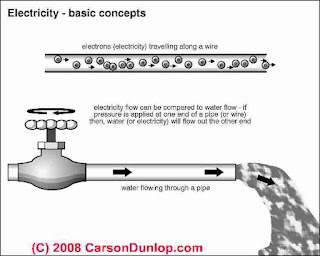মোট পৃষ্ঠাদর্শন
priest@Hasib. Blogger দ্বারা পরিচালিত.
Popular Posts
-
ট্রান্সফরমার কে প্যারালাল অপারেশন করবার জন্য কিছু নিদৃষ্ট শর্ত আসে যেগুলা মেনে প্যারালাল অপারেশন করতে হয়। শর্ত গুলি নিচে দেওয়া হলো - সব...
-
লাইটনিং এরেস্টার: লাইটনিং এরেস্টার হলো বজ্র রোধক। বৃষ্টির দিনে আকাশে যেই বজ্রপাত হয় তাতে লক্ষ লক্ষ ভোল্ট থাকে। এই বজ্র পাত পরিবাহী লাই...
-
লিকেজ ফ্লাক্স ট্রান্সফরমার এর প্রাইমারি তে AC সাপ্লাই প্রয়োগ করলে যে ফ্লাক্স সৃষ্টি হয় তার সম্পূর্ণ টি কোরের মধ্যে দিয়ে সেকেন্ডারি তে...
-
পরিবর্তনশীল তরিথ প্রবাহ (A .C ) কোনো একদিকে প্রবাহিত হইয়া শূন্য হইতে maximum এবং পরে আবার পুনরায় শূন্য হইলে এবং বিপরীতক্রমে ও যদি শূন্য হই...
-
কোনো পরিবর্তনশীল রাশির এক সাইকেল সম্পন্ন হতে যে সময় এর প্রয়োজন হয় তাকে পিরিয়ড বলে। ইহাকে T দ্বারা প্রকাশ করা হয়।
বুধবার, ১ জুলাই, ২০১৫
 What is An electric motor?
What is An electric motor?
 |
| Single Phase Electric Motor Principle. |
An electric motor uses electrical energy to produce mechanical energy, usually through the interaction of magnetic fields and current-carrying conductors.
শনিবার, ১৩ জুন, ২০১৫
 what is electric current?
what is electric current?
An electric current is a flow of electric charge. In electric circuits this charge is often carried by moving electrons in a wire. It can also be carried by ions in an electrolyte, or by both ions and electrons such as in a plasma.
The SI unit for measuring an electric current is the ampere, which is the flow of electric charge across a surface at the rate of one coulomb per second. Electric current is measured using a device called an ammeter.
তড়িৎ প্রবাহ বা electric current হচ্ছে electric চার্জ এর প্রবাহ বা চলাচল। তড়িৎ প্রবাহের এস আই একক হল অ্যাম্পিয়ার, সংকেত A।
The SI unit for measuring an electric current is the ampere, which is the flow of electric charge across a surface at the rate of one coulomb per second. Electric current is measured using a device called an ammeter.
তড়িৎ প্রবাহ বা electric current হচ্ছে electric চার্জ এর প্রবাহ বা চলাচল। তড়িৎ প্রবাহের এস আই একক হল অ্যাম্পিয়ার, সংকেত A।
এক অ্যাম্পিয়ার তড়িৎ প্রবাহ মানে কোনো পরিবাহীর মধ্য দিয়ে প্রতি সেকেন্ডে এক কুলম্ব electric চার্জ চলাচল করা।
সহজ করে বললে ইলেক্ট্রন আর প্রবাহকে ই কারেন্ট বলে।
 Define Voltage? ভোল্টেজ কাকে বলে ??
Define Voltage? ভোল্টেজ কাকে বলে ??
Voltage , electric potential difference, electric pressure or electric tension (denoted ∆V and measured in units of electric potential: volts, or joules per coulomb) is the electric energy charge difference of electric potential energy transported between two points. Voltage is equal to the work done per unit of charge against a static electric field to move the charge between two points.
ভোল্টেজ হচ্ছে বৈদ্যুতিক চাপ । পরিবাহীর পরমাণুগুলোর ঋণাত্বক কণিকা বা ইলেকট্রনসমূহকে স্থানচ্যুত করতে যে বল বা চাপের প্রয়োজন তাকে ভোল্টেজ বলে । ভোল্টেজের প্রতীক V এবং একক Volt (ভোল্ট)
"সহজ করে বলতে গেলে কোনো পরিবাহীর দুই প্রান্তের বিভব পার্থক্য কে ই আমরা ভোল্টেজ বলতে পারি।"
"অথবাইলেক্ট্রন কে চালনা করতে যে চাপের প্রয়োজন হয় সি চাপ তা ই হলো ভোল্টেজ। "
বৃহস্পতিবার, ১১ জুন, ২০১৫
 what is Electrical reactance ?
what is Electrical reactance ?
- Electrical reactance, the opposition to a change in voltage due to capacitance (capacitive reactance) or in current due to inductance (inductive reactance); the imaginary component of AC impedance
- Magnetic reactance, a similar effect in magnetism
- Reactance (psychology), an emotional reaction to pressure or persuasion that results in the strengthening or adoption of a contrary belief
Electrical reactance হলো সেই ধর্ম যার কারণে সার্কিট আর ভোল্টেজ ও কারেন্ট আর যে কোনো ধরণের পরিবর্তন কে বাধা দেয়। reactance সাধারনত দুই প্রকার capacitive reactance ও inductive reactance
capacitive reactance ভোল্টেজ আর যে কোনো পরিবর্তন কে বাধা দেয় আর inductive reactance কারেন্ট আর পরিবর্তন কে বাধা দেয়। inductive reactanceও capacitive reactance এর vectorial যোগ ফল কে impedance বলা হয় যাকে Z দ্বারা প্রকাশ করা হয়।
এতে সদস্যতা:
পোস্টগুলি (Atom)













